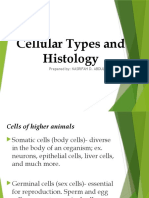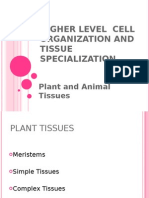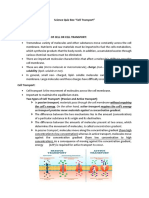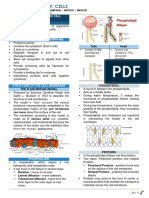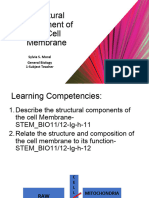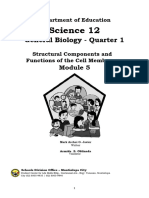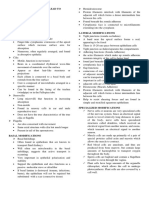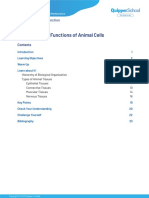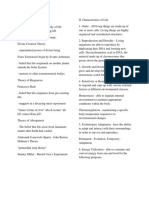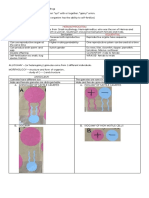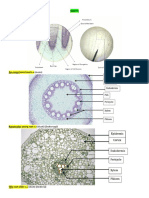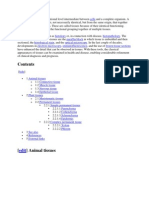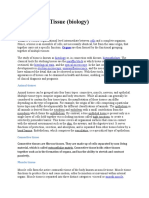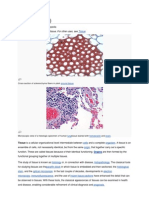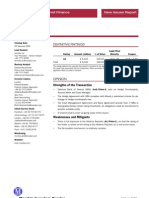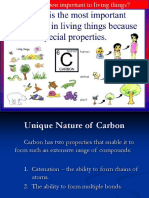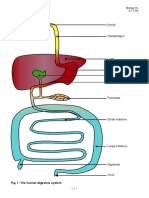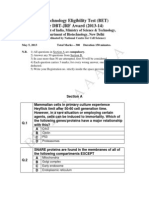Animal Cell
Animal Cell
Uploaded by
Nan Fen Jin SabolarceCopyright:
Available Formats
Animal Cell
Animal Cell
Uploaded by
Nan Fen Jin SabolarceCopyright
Available Formats
Share this document
Did you find this document useful?
Is this content inappropriate?
Copyright:
Available Formats
Animal Cell
Animal Cell
Uploaded by
Nan Fen Jin SabolarceCopyright:
Available Formats
ANIMAL CELL
PARTS AND FUNCTION OF ANIMAL CELL
Centrioles - Centrioles are self-replicating organelles made up of nine bundles of microtubules and are found only in animal cells. They appear to help in organizing cell division, but aren't essential to the process. Cilia and Flagella - For single-celled eukaryotes, cilia and flagella are essential for the locomotion of individual organisms. In multicellular organisms, cilia function to move fluid or materials past an immobile cell as well as moving a cell or group of cells. Endoplasmic Reticulum - The endoplasmic reticulum is a network of sacs that manufactures, processes, and transports chemical compounds for use inside and outside of the cell. It is connected to the double-layered nuclear envelope, providing a connection between the nucleus and the cytoplasm. Golgi Apparatus - The Golgi apparatus is the distribution and shipping department for the cell's chemical products. It modifies proteins and fats built in the endoplasmic reticulum and prepares them for export to the outside of the cell. Lysosomes - The main function of these microbodies is digestion. Lysosomes break down cellular waste products and debris from outside the cell into simple compounds, which are transferred to the cytoplasm as new cell-building materials. Microfilaments - Microfilaments are solid rods made of globular proteins called actin. These filaments are primarily structural in function and are an important component of the cytoskeleton. Microtubules - These straight, hollow cylinders, composed of tubulin protein, are found throughout the cytoplasm of all eukaryotic cells and perform a number of functions. Mitochondrion - Mitochondrion are oblong shaped organelles that are found in the cytoplasm of every eukaryotic cell. In the animal cell, they are the main power generators, converting oxygen and nutrients into energy. Nucleus - The nucleus is a highly specialized organelle that serves as the information and administrative center of the cell. Peroxisomes - Microbodies are a diverse group of organelles that are found in the cytoplasm, roughly spherical and bound by a single membrane. There are several types of microbodies but peroxisomes are the most common. Plasma Membrane - All living cells have a plasma membrane that encloses their contents. In prokaryotes, the membrane is the inner layer of protection surrounded by a rigid cell wall. Eukaryotic animal cells have only the membrane to contain and protect their contents. These membranes also regulate the passage of molecules in and out of the cells. Ribosomes - All living cells contain ribosomes, tiny organelles composed of approximately 60 percent RNA and 40 percent protein. In eukaryotes, ribosomes are made of four strands of RNA. In prokaryotes, they consist of three strands of RNA.
Tissue is a cellular organizational level intermediate between cells and a complete organism. A tissue is an ensemble of
cells, not necessarily identical, but from the same origin, that together carry out a specific function. These are called tissues because of their identical functioning.Organs are then formed by the functional grouping together of multiple tissues. The study of tissue is known as histology or, in connection with disease, histopathology. The classical tools for studying tissues are the paraffin block in which tissue is embedded and then sectioned, the histological stain, and the optical microscope. In the last couple of decades, developments in electron microscopy, immunofluorescence, and the use of frozen tissue sections have enhanced the detail that can be observed in tissues. With these tools, the classical appearances of tissues can be examined in health and disease, enabling considerable refinement of clinical diagnosis and prognosis. PAS diastase showing the fungus Histoplasma. Animal tissues can be grouped into four basic types: connective, muscle, nervous, and epithelial. Multiple tissue types comprise organs and body structures. While all animals can generally be considered to contain the four tissue types, the manifestation of these tissues can differ depending on the type of organism. For example, the origin of the cells comprising a particular tissue type may differ developmentally for different classifications of animals. The epithelium in all animals is derived from the ectoderm and endoderm with a small contribution from the mesoderm which forms the endothelium. By contrast, a true epithelial tissue is present only in a single layer of cells held together via occluding junctions called tight junctions, to create a selectively permeable barrier. This tissue covers all organismal surfaces that come in contact with the external environment such as the skin, the airways, and the digestive tract. It serves functions of protection, secretion, and absorption, and is separated from other tissues below by a basal lamina. Endothelium, which comprises the vasculature, is a specialized type of epithelium.
Connective tissue Connective tissues are fibrous tissues. They are made up of cells separated by non-living material, which is called extracellular matrix. Connective tissue gives shape to organs and holds them in place. Both blood and bone are examples of connective tissue. As the name implies, connective tissue serves a "connecting" function. It supports and binds other tissues. Unlike epithelial tissue, connective tissue typically has cells scattered throughout an extracellular matrix. Muscle tissue Muscle cells form the active contractile tissue of the body known as muscle tissue. Muscle tissue functions to produce force and cause motion, either locomotion or movement within internal organs. Muscle tissue is separated into three distinct categories: visceral or smooth muscle, which is found in the inner linings of organs; skeletal muscle, in which is found attached to bone providing for gross movement; and cardiac muscle which is found in the heart, allowing it to contract and pump blood throughout an organism. Nervous tissue Cells comprising the central nervous system and peripheral nervous system are classified as neural tissue. In the central nervous system, neural tissue forms the brain and spinal cord and, in the peripheral nervous system forms the cranial nerves and spinal nerves, inclusive of the motor neurons. Transmits communications. Epithelial tissue The epithelial tissues are formed by cells that cover organ surfaces such as the surface of the skin, the airways, the reproductive tract, and the inner lining of the digestive tract. The cells comprising an epithelial layer are linked via semipermeable, tight junctions; hence, this tissue provides a barrier between the external environment and the organ it covers. In addition to this protective function, epithelial tissue may also be specialized to function in secretion and absorption. Epithelial tissue helps to protect organisms from microorganisms, injury, and fluid loss. Plant tissues Cross-section of a flax plant stem with several layers of different tissue types: 1. Pith, 2. Protoxylem, 3. Xylem I, 4. Phloem I, 5. Sclerenchyma (bast fibre), 6. Cortex, 7. Epidermis Examples of tissue in other multicellular organisms are vascular tissue in plants, such as xylem and phloem. Plant tissues are categorized broadly into three tissue systems: the epidermis, the ground tissue, and the vascular tissue. Together they are often referred to as biomass.
Epidermis - Cells forming the outer surface of the leaves and of the young plant body. Vascular tissue - The primary components of vascular tissue are the xylem and phloem. These transport fluid and nutrients internally. Ground tissue - Ground tissue is less differentiated than other tissues. Ground tissue manufactures nutrients by photosynthesis and stores reserve nutrients.
Plant tissues can also be divided differently into two types:
1. Meristematic tissues
2. Permanent tissues Meristematic tissues Meristematic tissue consist of actively dividing cells this is found in regions such as the tips of stems or roots and lead to increase in length and thickness of the plant this cells are spherical oval polygonal and rectangular and have thin cells walls.The growth of plant occurs only in certain specific regions. At these regions, the meristematic tissues are present. New cells produced by meristem are initially those of meristem itself, but as they grow and mature, their characteristics slowly change and they become differentiated as components of other tissues. Depending on the region of occurrence of meristimatic tissues they are classified as: a) Apical Meristem - It is present at the growing tips of stems and roots and increases the length of the stem and root. They form growing parts at the apices of roots and stems and are responsible for increase in length,also called primary growth.This meristem is responsible for the linear growth of an organ. b) Lateral Meristem - This meristem consist of cells which mainly divide in one plane and cause the organ to increase in diameter and growth. Lateral Meristem usually occurs beneath the bark of the tree in the form of Cork Cambium and in vascular bundles of dicots in the form of vascular cambium. The activity of this cambium results in the formation of secondary growth. c) Intercalary Meristem - This meristem is located in between permanent tissues. It is usually present at the base of node, inter node and on leaf base. They are responsible for growth in length of the plant.This adds growth in the girth of stem.
The cells of meristematic tissues are similar in structure and have thin and elastic primary cell wall made up of cellulose. They are compactly arranged without inter-cellular spaces between them. Each cell contains a dense cytoplasm and a prominent nucleus. Dense protoplasm of meristematic cells contains very few vacuoles. Normally the meristematic cells are oval, polygonal or rectangular in shape. Meristemetic tissue cells have a large nucleus with small or no vacuoles, they have no inter cellular spaces. Permanent tissues The meristematic tissues that take up a specific role lose the ability to divide. This process of taking up a permanent shape, size and a function is called cellular differentiation. Cells of meristematic tissue differentiate to form different types of permanent tissue. There are 2 types of permanent tissues: 1. simple permanent tissues 2. complex permanent tissues Simple permanent tissues These tissues are called simple because they are composed of similar types of cells which have common origin and function. They are further classified into:
1. Parenchyma 2. Collenchyma 3. Sclerenchyma 4. Epidermis
Parenchyma is the most specialized primitive tissue. It mainly consists of thin-walled cells which have intercellular spaces between them. The cell wall is made up primarily of cellulose. Each parenchymatous cell is iso-diametric, or roughly spherical in shape. This tissue is widely distributed in various plant organs, but it mainly occurs in the cortex, epidermis, and pith, as well as in the mesophyll of leaves. The main function of parenchymatous tissue is assimilation and storage of reserve food materials like starch, fats and proteins. They also store waste products such as gums, resins, and inorganic waste materials. Specialized forms of parenchyma include chlorenchyma and aerenchyma. Chlorenchyma cells are characterized by having many chloroplasts (containing chlorophyll). This tissue is found in the palisade and spongy tissues in the green leaves and the stem cortex of the herbs where photosynthesis occurs. Aerenchyma is a forms of parenchyma possessing large air cavities. In aquatic plants the cavities in the intercellular spaces give buoyancy to the plant and help them float in water. Collenchyma is Greek word where "Collen" means gum and "enchyma" means infusion. It is a living tissue of primary body like Parenchyma. Cells are thin-walled but possess thickening of cellulose and pectin substances at the corners where number of cells join together. This tissue gives a tensile strength to the plant and the cells are compactly arranged and do not have inter-cellular spaces. It occurs chiefly in hypodermis of stems and leaves. It is absent in monocots and in roots. Collenchymatous tissue acts as a supporting tissue in stems of young plants. It provides mechanical support, elasticity, and tensile strength to the plant body. It helps in manufacturing sugar and storing it as starch. It is present in margin of leaves and resist tearing effect of the wind. [edit] Sclerenchyma Sclerenchyma is Greek word where "Sclrenes" means hard and "enchyma" means infusion. This tissue consists of thickwalled, dead cells. These cells have hard and extremely thick secondary walls due to uniform distribution of lignin. Lignin deposition is so thick that the cell walls become strong, rigid and impermeable to water. Sclerenchymatous cells are closely packed without inter-cellular spaces between them. Thus, they appear as hexagonal net in transverse section. The cells are cemented with the help of lamella. The middle lamella is a wall that lies between adjacent cells. Sclerenchymatous cells mainly occur in hypodermis, pericycle, secondary xylem and phloem. They also occur in endocorp of almond and coconut. It is made of pectin, lignin, protein. The cells of sclerenchymatous cells can be classified as :
1. Fibres- Fibres are long, elongated sclerenchymatous cells with pointed ends. 2. Sclerides- Sclerenchymatous cells which are short and possess extremely thick, lamellated, lignified walls with long
singular piths. They are called sclerides. The main function of Sclerenchymatous tissues is to give support to the plant. Epidermis The entire surface of the plant consists of a single layer of cells called epidermis or surface tissue. The entire surface of the plant has this outer layer of epidermis. Hence it is also called surface tissue. Most of the epidermal cells are relatively flat. the outer and lateral walls of the cell are often thicker than the inner walls. The cells forms a continuous sheet without inter cellular spaces. It protects all parts of the plant. Complex permanent tissue A complex permanent tissue may be classified as a group of more than one type of tissue having a common origin and working together as a unit to perform a function. These tissues are concerned with transportation of water, mineral, nutrients and organic substances. The important complex tissues in vascular plants are xylem, phloem. Xylem
Xylem is a chief, conducting tissue of vascular plants. It is responsible for conduction of water and mineral ions. Xylem is a very important plant tissue as it is part of the plumbing of a plant. Think of bundles of pipes running along the main axis of stems and roots. It carries water and dissolved substances throughout and consists of a combination of parenchyma cells, fibers, vessels, tracheids and ray cells. Long tubes made up of individual cells are the vessels, while vessel members are open at each end. Internally, there may be bars of wall material extending across the open space. These cells are joined end to end to form long tubes. Vessel members and tracheids are dead at maturity. Tracheids have thick secondary cell walls and are tapered at the ends. They do not have end openings such as the vessels. The tracheids ends overlap with each other, with pairs of pits present. The pit pairs allow water to pass from cell to cell. While most conduction in the xylem is up and down, there is some side-to-side or lateral conduction via rays. Rays are horizontal rows of long-living parenchyma cells that arise out of the vascular cambium. In trees, and other woody plants, ray will radiate out from the center of stems and roots and in cross-section will look like the spokes of a wheel. Phloem Phloem is an equally important plant tissue as it also is part of the plumbing of a plant. Primarily, phloem carries dissolved food substances throughout the plant. This conduction system is composed of sieve-tube member and companion cells, that are without secondary walls. The parent cells of the vascular cambium produce both xylem and phloem. This usually also includes fibers, parenchyma and ray cells. Sieve tubes are formed from sieve-tube members laid end to end. The end walls, unlike vessel members in xylem, do not have openings. The end walls, however, are full of small pores where cytoplasm extends from cell to cell. These porous connections are called sieve plates. In spite of the fact that their cytoplasm is actively involved in the conduction of food materials, sieve-tube members do not have nuclei at maturity. It is the companion cells that are nestled between sieve-tube members that function in some manner bringing about the conduction of food. Sieve-tube members that are alive contain a polymer called callose. Callose stays in solution as long at the cell contents are under pressure. As a repair mechanism, if an insect injures a cell and the pressure drops, the callose will precipitate. However, the callose and a phloem protein will be moved through the nearest sieve plate where they will form a plug. This prevents further leakage of sieve tube contents and the injury is not necessarily fatal to overall plant turgor pressure. Phloem transports food and materials in plants in upwards and downwards as required.
You might also like
- Written Work 1 CellDocument5 pagesWritten Work 1 CellAnna Liza CarrascalNo ratings yet
- Vacuum Dewatering FlooringDocument4 pagesVacuum Dewatering FlooringArunava Das100% (1)
- CCR Operators Interview QuestionDocument3 pagesCCR Operators Interview QuestionHashim Bukhari100% (1)
- Gen Bio Cell TypesDocument27 pagesGen Bio Cell TypesJonaya AmpasoNo ratings yet
- Plant and Animal TissuesDocument27 pagesPlant and Animal TissuesDoods GaldoNo ratings yet
- The Cell TheoryDocument29 pagesThe Cell TheoryKian Hanz Señerez AquinoNo ratings yet
- Session No. 1.2. Cell Types and ModificationsDocument48 pagesSession No. 1.2. Cell Types and ModificationsShekaina Faith Cuizon LozadaNo ratings yet
- Immune System and Sensory Motor MechanismsDocument29 pagesImmune System and Sensory Motor MechanismsSheila AdelaidaNo ratings yet
- General Biology Module 2Document11 pagesGeneral Biology Module 2Jee-Anne Herbulario100% (1)
- Gen Bio 1 - PretestDocument3 pagesGen Bio 1 - PretestApz venturaNo ratings yet
- Lesson 1 Cell Theory Gen. Bio 1Document27 pagesLesson 1 Cell Theory Gen. Bio 1Trisha Anthony Cortaz100% (1)
- Cell Transport ReviewerDocument9 pagesCell Transport ReviewerNa LuNo ratings yet
- BioenergeticsDocument24 pagesBioenergeticsJl ImperialNo ratings yet
- Membrane Structure and FunctionDocument62 pagesMembrane Structure and Functionkatherine corveraNo ratings yet
- Session No 1.1. A Tour of The CellDocument40 pagesSession No 1.1. A Tour of The CellShekaina Faith Cuizon LozadaNo ratings yet
- Cell TheoryDocument2 pagesCell TheoryexcanvireNo ratings yet
- Cell Modifications: Microvilli Cilia FlagellaDocument19 pagesCell Modifications: Microvilli Cilia FlagellaDaniel CraigNo ratings yet
- EVALUATE - Quiz 1 (Intro To Bio, Cell Theory, Cell Types, Structure and Function) - General Biology 1Document16 pagesEVALUATE - Quiz 1 (Intro To Bio, Cell Theory, Cell Types, Structure and Function) - General Biology 1gcjar vllnNo ratings yet
- Coupled Reaction and ATPDocument31 pagesCoupled Reaction and ATPFGalsim, Jaimee Celestine P.No ratings yet
- Biological MacromoleculesDocument36 pagesBiological MacromoleculesArthur LaurelNo ratings yet
- Cell ModificationDocument2 pagesCell ModificationLovelle Jade RuizNo ratings yet
- Reviewer For Formative Assessment Gen Bio 2Document1 pageReviewer For Formative Assessment Gen Bio 2Melanie ArangelNo ratings yet
- Cell Theory Module 2Document16 pagesCell Theory Module 2Noerael Jade CaliNo ratings yet
- Genbio I Reviewer Quarter 2Document24 pagesGenbio I Reviewer Quarter 2alliztairgabriellabartolome18No ratings yet
- GenBio - 1st QuarterDocument13 pagesGenBio - 1st QuarterCc TvNo ratings yet
- Lesson 1: Biological MoleculesDocument60 pagesLesson 1: Biological MoleculesbuttewcupzNo ratings yet
- Sensory and Motor MechanismDocument7 pagesSensory and Motor Mechanism박자닌100% (1)
- Department of Education: Learning Activity Worksheets (LAW) General Biology 1 Grade 12Document3 pagesDepartment of Education: Learning Activity Worksheets (LAW) General Biology 1 Grade 12Maria Bettina DizonNo ratings yet
- STEM Gen Bio 1 Q1 M3Document14 pagesSTEM Gen Bio 1 Q1 M3Roland Agra100% (1)
- BIO - Cell Organelle WSDocument3 pagesBIO - Cell Organelle WSdabmastr05No ratings yet
- Structural Components of The Cell MembraneDocument17 pagesStructural Components of The Cell MembraneAshley Nicole VillegasNo ratings yet
- Plant Cell and Animal CellDocument12 pagesPlant Cell and Animal CellKimverheart Dennisse NavalNo ratings yet
- General BiologyDocument8 pagesGeneral BiologyAngelica MarasiganNo ratings yet
- Concept of LifeDocument28 pagesConcept of LifeJesh RishNo ratings yet
- Q3.2 History of Life On Earth: General Biology 2Document23 pagesQ3.2 History of Life On Earth: General Biology 2charlotteNo ratings yet
- Biology Module 1Document15 pagesBiology Module 1Joemmel MagnayeNo ratings yet
- General Biology 1 Module 5Document21 pagesGeneral Biology 1 Module 5Vienne MonroidNo ratings yet
- Prokaryotic and Eukaryotic Cells ReviewerDocument5 pagesProkaryotic and Eukaryotic Cells ReviewerAnna Kathleen LimNo ratings yet
- Cell Modifications That Lead To AdaptationDocument1 pageCell Modifications That Lead To AdaptationChris EismaNo ratings yet
- General Biology 1: Prepared By: Pamela May L. Raposa RN, LPTDocument21 pagesGeneral Biology 1: Prepared By: Pamela May L. Raposa RN, LPTJean Raziel Mantes100% (1)
- Module 1Document9 pagesModule 1Ivan PaulinoNo ratings yet
- GENBIO 2 Midterm Reviewer - JMDPDocument4 pagesGENBIO 2 Midterm Reviewer - JMDPJhianne Mylz ParañalNo ratings yet
- Plant Tissues and The Multicellular Plant BodyDocument4 pagesPlant Tissues and The Multicellular Plant BodyAnonymous HXLczq3100% (1)
- Bio2 11 - 12 Q3 0402 PF FDDocument38 pagesBio2 11 - 12 Q3 0402 PF FDLindsay SicatNo ratings yet
- Cell TheoryDocument12 pagesCell TheoryRonalyn Ramos Castro100% (1)
- Session No. 2.2. Biological Molecules - Proteins and EnzymesDocument39 pagesSession No. 2.2. Biological Molecules - Proteins and EnzymesShekaina Faith Cuizon LozadaNo ratings yet
- Exchange of Gases in AnimalsDocument23 pagesExchange of Gases in AnimalsHenry JacobNo ratings yet
- Biology Write UpDocument7 pagesBiology Write UpAnnie Cristobal EscotoNo ratings yet
- Lesson 1Document11 pagesLesson 1remshopNo ratings yet
- UNIT 2 Lesson 2.2 Structures of Animal CellsDocument24 pagesUNIT 2 Lesson 2.2 Structures of Animal CellsKatznjammr100% (1)
- Gen Bio ReviewerDocument4 pagesGen Bio ReviewerJoeselle Anne SampagaNo ratings yet
- General Biology 2 NotesDocument17 pagesGeneral Biology 2 NotesAlyssa Mae BinoNo ratings yet
- GenBio 1 Lesson 1 ATP and ADP CycleDocument2 pagesGenBio 1 Lesson 1 ATP and ADP CycleLlaban MunicaNo ratings yet
- Cell TheoryDocument10 pagesCell TheoryLuigi Miguel G. TiranaNo ratings yet
- Atp Adp CycleDocument18 pagesAtp Adp CycleLyn Dela Cruz Fontila100% (1)
- Roots: Allium (Onion) Root Tip L.S (Mono)Document11 pagesRoots: Allium (Onion) Root Tip L.S (Mono)reeNo ratings yet
- Love of Lab 1: Spontaneous Generation vs. BiogenesisDocument7 pagesLove of Lab 1: Spontaneous Generation vs. Biogenesisi believe in dabdab and bambamNo ratings yet
- General Biology 2Document33 pagesGeneral Biology 2Treshia Jazmin EguinNo ratings yet
- Tissue Is A Cellular Organizational Level Intermediate Between Cells and A Complete OrganismDocument7 pagesTissue Is A Cellular Organizational Level Intermediate Between Cells and A Complete OrganismErneyann BibeyzNo ratings yet
- Tissues and Cells Part 1 - Grade 7 - BiologyDocument4 pagesTissues and Cells Part 1 - Grade 7 - BiologyYasmina Jamal GholoumNo ratings yet
- TissueDocument36 pagesTissueMinan Fahnanza100% (1)
- Tissue - WikipediaDocument42 pagesTissue - WikipediaLumina More100% (1)
- Moody's TitlosDocument6 pagesMoody's TitlosVasilis TsekourasNo ratings yet
- CZ EE 2023 ColemanDocument190 pagesCZ EE 2023 ColemanpostmalNo ratings yet
- 2 Polymer Optimization For Centrifuge Dewatering PDFDocument48 pages2 Polymer Optimization For Centrifuge Dewatering PDFAnonymous Hy5Ir9QXNo ratings yet
- Introduction To Community PediatricsDocument24 pagesIntroduction To Community PediatricsAlex perrieNo ratings yet
- Carica Batteria - Arjo - NEA8000-WWDocument17 pagesCarica Batteria - Arjo - NEA8000-WWAnfyNo ratings yet
- Weidmuller Cat10 ShortForm SmartDocument164 pagesWeidmuller Cat10 ShortForm SmartCesar Solis TarangoNo ratings yet
- SURPASS 3-Páginas-EliminadasDocument3 pagesSURPASS 3-Páginas-EliminadasJung Ho SeokNo ratings yet
- CTC ST Itp 001 Structural enDocument2 pagesCTC ST Itp 001 Structural enNaim AburayyamNo ratings yet
- 4 Great Methods To Make Graphene at Home, Along With Graphene BasicsDocument12 pages4 Great Methods To Make Graphene at Home, Along With Graphene BasicsNaga RajuNo ratings yet
- Sweden Swede Lussekater: Sweden: Köttbullar (Meatballs)Document4 pagesSweden Swede Lussekater: Sweden: Köttbullar (Meatballs)Claudia GonzalesNo ratings yet
- 15 Unique Nature of CarbonDocument17 pages15 Unique Nature of CarbonlairinNo ratings yet
- Wsia PDC1Document3 pagesWsia PDC1hanisahhamzah100% (1)
- IB HL Biology Notes: DigestionDocument9 pagesIB HL Biology Notes: DigestionayushfmNo ratings yet
- DBT BET Question Paper With 2013 Answer KeyDocument62 pagesDBT BET Question Paper With 2013 Answer KeyAbhay Kumar100% (6)
- Jayanth TNSTC ProposalDocument4 pagesJayanth TNSTC ProposalP JayanthNo ratings yet
- CCTV Sub-1Document2 pagesCCTV Sub-1Giovanni TandogNo ratings yet
- CT WKM Ball Trun 370d4 02Document40 pagesCT WKM Ball Trun 370d4 02Andersson Benito HerreraNo ratings yet
- Treatise of ChamalongosDocument15 pagesTreatise of ChamalongosAli Sarwari-Qadri100% (6)
- TRY OUT PSAJ GUGUS 6 2024 Big6-1Document11 pagesTRY OUT PSAJ GUGUS 6 2024 Big6-1fitrianilasari94No ratings yet
- How To Do Kegel Exercises PDFDocument2 pagesHow To Do Kegel Exercises PDFAyu Maindra100% (1)
- Quiz 1-3Document6 pagesQuiz 1-3Ailyn Balmes100% (1)
- Chapter 2 ChangDocument41 pagesChapter 2 ChangAlexis ChavezNo ratings yet
- Mid I 173 OnlineDocument1 pageMid I 173 OnlineShafiqul Haque Bhuiyan ShuvoNo ratings yet
- Fiitjee: Physics, Chemistry & MathematicsDocument16 pagesFiitjee: Physics, Chemistry & Mathematicsmehul pantNo ratings yet
- Heavy Bag HittingDocument4 pagesHeavy Bag HittingBrad Tennent100% (1)
- John Driscoll v. Gloucester CityDocument12 pagesJohn Driscoll v. Gloucester CityNewJerseyPublicRadioNo ratings yet
- Epidemiology Dissertation ProposalDocument8 pagesEpidemiology Dissertation ProposalOnlinePaperWriterFargo100% (1)
- 150KW 3300V Induction MotorDocument2 pages150KW 3300V Induction MotorManisha KharwarNo ratings yet



